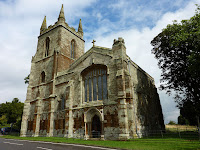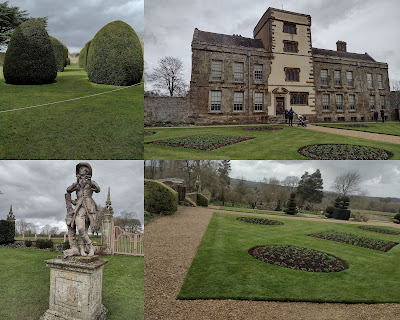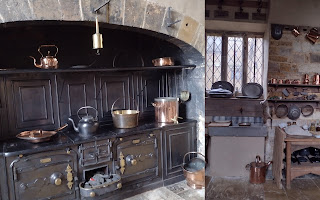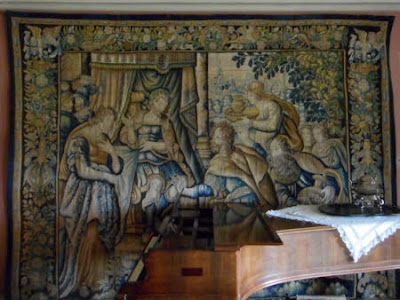Last Monday I was with my SIL Barbara in Northamptonshire. We had a lovely long weekend with her. She lives in a little village just south of Rugby - and it was amazing to wake up each morning and look out of the window across her garden to the field beyond. It's particularly interesting because records show it has been kept for pasture since at least 1600AD - and the earliest inhabitants, who ploughed it 1100 years ago used the old medieval ridge and furrow method. You can still see these humps today - a fairly rare example of a medieval village!
On Sunday we visited nearby Canons Ashby, a fine NT property with an interesting history. This Tudor manor house has been in the Dryden family for over 400 years, and various occupants have added to and altered the house and gardens.
Across the road is St Mary's Church - originally part of a huge priory, built around 1150. Situated on the busy road between Oxford and Northampton, there were plenty of travellers needed hospitality. The Priory rapidly became very wealthy. Sadly the distracting temptations offered by passing nobility became too much.

Most of the buildings were demolished, but various Drydens reclaimed the building materials for work on their house. The second Dryden to live there, Erasmus, extended the farmhouse, and commissioned all sorts of murals.
We entered the house through an archway into a courtyard, and the Covid-safe route led us first into the kitchen. Here's Bob and Barbara patiently waiting for me to take the picture!I'm a sucker for Victorian kitchens like this, with all the copper pans. The flagstones are from the Priory.There were lots of amazing portraits. Lady Elizabeth Cornwallis, dressed as Diana the Huntress [painted 1662] She was related to the Poet Laureate John Dryden
Sir Henry Dryden inherited the property in 1837, just 19 years old. Nicknamed "The Antiquary", he was passionately interested in history and was determined to restore the house to its full glory. He changed the mullioned windows for sash, and added a façade of dressed stone. He left his studies at Oxford and declared he would not marry till the house was sorted and he was out of debt! He kept to this - finally marrying Fanny Tredcroft [42] when he was 47. They had one daughter, Alice. He wanted his home to be a Palladian beauty. Sadly he never discovered Erasmus' 16thC murals of the prophet Jereboam which had been overpainted. These only came to light during a NT restoration project in the late 20thC.









Sounds like a lovely place to visit. :)
ReplyDeleteOh it was - my pictures do not do it justice
DeleteI'm glad you had a weekend away. It sounds most jolly and enjoyable.x
ReplyDeleteYes! Family time is precious
DeleteThat looks a most interesting place to visit. i imagine the gardens will be a treat later on.
ReplyDeleteWe hope to go back!
DeleteThat looks like a lovely visit. I love the continence of Scipio story, thank you for sharing it.
ReplyDeleteI was interested in the tapestry's real subject which I had never heard of. I like the old kitchen, which reminds me of the one at Hampton Court Palace, which also has wonderful cooking pots if I remember correctly.
ReplyDeleteHandel wrote an opera in 3 acts based on the story. His "March from Scipio" is sometimes played as a wedding march.
ReplyDeleteI learned something new again. Of course I recognize the music, having checked Youtube.
DeleteI realised that already I knew it, once. I checked it out, altho I did not know the whole opera or the story behind it
Delete